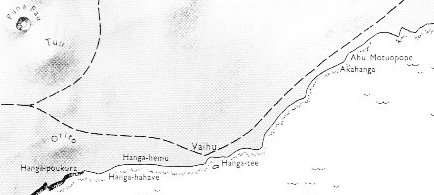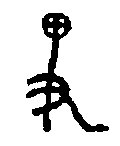|
TRANSLATIONS
We can assume that the ancient system (which I have tried to reconstruct) of counting the year, viz. as two cycles built on 6 double fortnights (6 * 28 = 168) + an extra last half period, resulting in 13 * 14 = 182 days, was created by people who knew π. The pattern with double cycles (e.g. 2 * 7 = 14, 2 * 14 = 28, 2 * 182 = 364) resembles how the circumference of the circle is measure by using this number in connection with the radius and 2. For mathematical reasons it is quite impossible to change the value of π into a value twice as large. It would destroy the picture in which π fits like a gem. In the sacred geography of Easter Island Te Pei is like the 'navel' of the circle of the year. There are two ways out from Te Pei - one towards southwest and one towards southeast. Each functions as a radius in time, necessary to measure out half the year. I have a suspicion that the name Te Pei is connected with the name we use for π, and in between Easter Island and our western world lies China: ... The most ancient of all astronomical instruments, at least in China, was the simple vertical pole. With this one could measure the length of the sun's shadow by day to determine the solstices ... and the transits of stars by night to observe the revolution of the sidereal year. It was called pei or piao, the meaning of the former being essentially a post or pillar, and the latter an indicator. Pei can be written with the bone radical ... or with the wood radical, in which case it means a shaft or handle. Ancient oracle-bone forms of the phonetic component show a hand holding what seems to be a pole with the sun behind it at the top ...
so that although this component alone came to mean 'low' in general, it may perhaps have referred originally to the gnomon itself. This is after all an object low on the ground in comparison with the sun, and shows the long shadow of a low sun at the winter solstice, the moment which the Chinese always took as the beginning of the tropic year." (Needham 3) The measuring instrument was called pei - or alternatively piao - which makes it into a link between our name for π and Te Pei. A name is never securely connected with its object, and it is not strange that the pole (Te Pou) is coming as the kuhane station following Te Pei. And then, with Te Pou obviously pointing to the sky and being connected with the sky, the rule of basic logic is to have a contrast in the station immediately adjacent. It became the preceding station Te Pei. The sky is raised from a state of primordial misty chaos, which became Te Pei. There cannot be two 'navels' in the circle of the year, and we will therefore look in vain for parallel twin kuhane stations half a year later. Let us now look closer on 'facts' as described in Barthel 2: "The dream soul turned around and hurried back to Hiva, to its (Home)land, to Maori. She slipped into the (sleeping) body of Hau Maka, and the body of Hau Maka awakened. He arose and said full of amazement: 'Ah' and thought about the dream. Hua Tava heard him saying 'Ah' and asked from another end of the house, 'What is it that amazes you so?' Hau Maka replied, 'That which amazes me is a dream.' Then Hua Tava said, 'How well you must have fared in this dream, oh companion! Tell me about your dream.' Hau Maka told about his dream: 'I was sleeping, and this is what happened: My dream soul moved on, and, through the power of her mana, my dream soul reached seven lands, which were lying in the midst of a dim twilight. My dream soul looked around searchingly, but these lands were not very good at all. In the midst of a dim twilight there is Te Pei, the residence. Not even eight groups of people (i.e., countless boat crews) can find the small piece (of land?) again once it has been lost. But one (can) take possession of the eight land: (It lies) 'on high', (it) juts out (on the horizon), and its contours stand out against the (rising) sun (i.e., in the east) ..." With my perspective Te Pei becomes a point which is determined by the solar journey over the year. The rising sun is used. A landmark on the horizon is an alternative to a gnomon. "2. The search of the dream soul for a future homeland is complicated by the fact that she can see the islands only in a 'dim twilight' (te nehunehu kapuapua). Leonardo Pakarati explained this situation with the expression that follows in the text (i te pei 'during the fast journey'). He said the dream soul had built up so much speed (as if gliding down a grassy slope with a sled, RAP. pei) that she could see the land below her only in a blur. This interpretation by a modern Easter Islander is still moot, however. On other Polynesian islands, pei (or pehi) is the name of a game of skill that involves throwing. In MAO. it can mean 'earth; clump of earth', which may be a possible translation when there is talk of a 'clump of earth as residence' (ko te pei te nohonga) or of 'Te Pei', which can be lost and found. Te Pei is also the name of a place on the southern shore of Easter Island. The six references in the text do not allow for a general definition, but perhaps an expression from Mangaia can provide some insight: 'Hina alone keeps seven, yes eight balls in motion' (Pei aea i te pei itu, i te pei varu, é Ina é, Tregear 1891: 596). Here an outstanding achievement is characterized by the ability to extend control beyond seven to eight. The expression 'dim twilight' shows up in a slightly altered form in the recitations (ko te ehuehu, ko te kapuapua, '... the grey smoke ... that which is hazy', Barthel 1960:855 and 842; 'Es la hora de la penumbra y hay neblina suave', Campbell 1971:404 and 419) and, in this context at least, seems to refer to a natural phenomenon." Te Pou is Sirius, the most conspicious star in the sky. Te Pei should contrariwise be not only connected with earth below but also be inconspicious, hard to find. "With the aid of my key informant, I was also able to chart the less well known places. The dream soul names 'Te Piringa Aniva', east of Hanga Pau Kura, 'Te Pei', a few hundred meters farther on and across from Motu Roa, and 'Te Pou', east of Vaihu ..."  But the moon (Hina) can give guidance, because it is a matter of finding Te Pei in time. She can keep not only seven but eight balls in order. The kuhane stations are 8 + 8 = 16 in the text of G. The 8th is Te Pei, and it being so difficult to see (like the dark pe'i fish in the deep) a new cycle is needed, a new fire must be alighted - Sirius. If we count each cycle as 182 days, we can easily find 7 * 24 = 168 of them, but then comes 14 (not the expected 12). Hina is needed to find those 14. With Te Pei in G at day 8 * 29.5 = 236, there are 68 glyphs in excess over 168, which suggests a connection. 68 / 4 = 17, and 168 + 17 = 185. The speed (fast journey, i te pei) I have earlier tried to explain by the necessity for the sun to move quickly as lightning from the south hemisphere to the north (where he must be reborn at winter solstice). This theoretical construct may have been visualized by the hour glass, which can be imagined as turned around at summer solstice. I think they (some of them) must have known about the hour glass. The sands of One Tea is an allusion, I guess. Time has run out for the primary time giver Hina, and all sand has landed on earth. |
